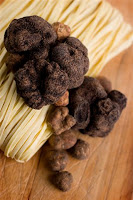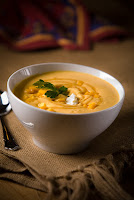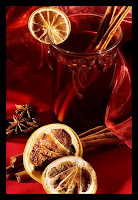Growing up in the northeast, fall always had a special feeling to it. The cooling of the nights, the touch of color in the leaves and the anticipation of the coming holiday season always gave the air clarity, as if shaking off the haze of summer. For me, one thing that always stood out were my trips in mid October to Van Ripers, or Tice's Farms in northern New Jersey. Insert any name from any state and I'm sure you can fill in the name of the farm stand where you went as a child.


The smell of freshly made donuts, watching through the window while cider is being fresh pressed, and people starting to get that wistful look in their eyes as they start to glimpse the hint of Thanksgiving and Christmas just over the horizon. We would return home with arms full of fresh produce, apples, cider, fresh donuts, placing our pumpkins on the front stoop to await their fateful appointment with the carving knife that would soon transform them into the Jack-o-Lanterns for Halloween night.

Autumn has long been associated with the transition from warm to cold weather, the primary harvest has dominated its themes and popular images throughout the world. In western cultures, personifications of autumn are usually
pretty, well-fed females adorned with fruits, vegetables, grains and wheat that ripen at this time. Most ancient cultures featured
autumnal celebrations of the harvest, often the most important on their calendars. Still extant echoes of these celebrations are found in the mid-autumn Thanksgiving holiday of the United States,

and the Jewish Sukkot holiday, with its roots as a full moon harvest festival of "tabernacles", (
huts wherein the harvest was processed and which later gained religious significance).
There are also the many North American Indian festivals tied to harvest of
autumnally ripe foods gathered in the wild, the Chinese Mid-Autumn or Moon
festival as well as many others. The predominant mood of these celebrations is a gladness for the fruits of the earth mixed with a certain melancholy linked to the imminent arrival of harsh weather.
Autumn Produce
Squash
The term "summer" and "winter" for squash are only based on current usage, not on actuality. "Summer" types are on the market all winter; and "winter" types are on the markets in the late summer and fall, as well as winter.
 Acorn
Acorn This winter squash is shaped like an acorn. Great for baking. A small acorn squash weighs from 1 to 3 pounds, and has sweet, slightly fibrous flesh. In addition to the dark green acorn, there are now golden and multi-colored varieties.
 Ambercup
Ambercup A relative of the buttercup squash that resembles a small pumpkin. Bright orange flesh has a dry sweet taste. This can be stored for quite a long time.
 Butternut
Butternut Beige colored and shaped like a vase, this is a more watery squash and tastes somewhat similar to sweet potatoes. It has a bulbous end and pale, creamy skin, with a choice, fine-textured, deep-orange flesh with a sweet, nutty flavor. It weighs from 2 to 5 pounds. The more orange the color, the riper, drier and sweeter the squash.
 Spaghetti
Spaghetti A small, watermelon-shaped variety, ranges in size from 2 to 5 pounds or more. It has a golden-yellow, oval rind and a mild, nut-like flavor. When cooked, the flesh separates in strands that resemble spaghetti. The most yellow squash will be the ripest and best to eat. Those that are nearly white are not very ripe. Spaghetti squash also freezes well.
Chestnuts

In Europe, Asia and Africa, chestnuts are often used as an everyday potato substitute. Although they are wonderful straight from the oven or fireplace, you can make use of the winter chestnut crop in many ways, both sweet and savory. Before trying one of the many chestnut recipes, learn about chestnut history and how to store them.
Probably one of the first foods eaten by man, the chestnut dates back to prehistoric times. The majority of the chestnut trees currently found in

America are of native European stock, but Native Americans feasted on America's own variety, Castanea dentata, long before European immigrants introduced their stock to America. Today, most of the chestnut food crop is imported from Japan, China, Spain, and Italy. Legend has it that the Greek army survived on their stores of chestnuts during their retreat from Asia Minor in 401-399 B.C. Chestnuts contain twice as much starch as potatoes. It is no wonder they are still an important food crop in China, Japan, and southern Europe where they are often ground into a meal for bread-making, thus giving rise to the nickname of "bread tree."
Pumpkins
As one of the most popular crops in the United States, 1.5 billion pounds of pumpkins are produced each year. The top pumpkin producing states in the U.S. include Illinois, Ohio, Pennsylvania, and California. Pumpkins are a warm weather crop that are usually planted in early July.

When ripe, the pumpkin can be boiled, baked, steamed, or roasted. Often, it is made into various kinds of pie which is a traditional staple of the Canadian and American Thanksgiving holiday. Pumpkins that are still small and green may be eaten in the same way as the vegetable marrow/zucchini. Pumpkins can also be eaten mashed or incorporated into soup. In the Middle East, pumpkin is used for sweet dishes; a well-known sweet delicacy is called halawa yaqtin. In South Asian countries like India, pumpkin is cooked with butter, sugar, and spices; this
dish is called kadu ka halwa. In Guangxi province, China, the leaves of the pumpkin plant are consumed as a cooked vegetable or in soups. In Australia, pumpkin is often roasted in conjunction with other vegetables. In

Japan, small pumpkins are served in savory dishes, including tempura. In Thailand, small pumpkins are steamed with custard inside and served as a dessert. In Italy it can be used, with cheeses, as a savory stuffing for ravioli. And also, pumpkin can be used to flavor both alcoholic and nonalcoholic beverages.
An International Look at Autumn Cuisine
 China
China
Mooncakes are the highlight of China's annual Mid-Autumn Moon Festival.
Mediterranean
Autumn is the beautiful time on the Mediterranean, olives and grapes are ripening, it's cooler and wonderful to just stay in the moment and eat some old-fashioned food.
 Italy
Italy
Savor the best of the Piedmont at Alba's famous Truffle Festival. Plus, wonderful classic Piedmontese cuisine, rich and pairing perfectly with the region's famous sultry red wines.
Japan

There is lots of delicious food to eat in Japan when autumn comes, and that is the meaning behind the expression, shokuyoku no aki ("autumn, the season of hearty appetites"). A fish called samma (Pacific saury) is in prime condition during the fall, making it a delicious treat. The characters for samma are written "autumn-blade-fish, "implying that this fish is most delicious in autumn. Matsutake mushrooms is the tastiest and most sought-after autumn food in Japan.
Check back through the next two months as I will be bringing you
features and recipes for fall classics and treats.
As always, Bon Appetit,
Lou
 I thought I'd post a special treat for Valentines day and because this, February, is the month of amore. The challenge for these GGM chefs, Pastry Chef Paw Mikkelsen and Chocolatier Ingo Wullert was to use an imported blood orange juice imported from Sicily. Well, the phrase great minds think alike has never been more true. Paw and Ingo have brought two wonderful variations of a blood orange mousse that will have your lover literally eating out of the palm of your hand. Hmmm.....this could get interesting. And, the great thing about them is that while they may look intimidating, that's just due the presentation. With a just a little time, patience and practice, you too can get fancy in the kitchen. The recipes are easy to follow and the home cook will have no problem.
I thought I'd post a special treat for Valentines day and because this, February, is the month of amore. The challenge for these GGM chefs, Pastry Chef Paw Mikkelsen and Chocolatier Ingo Wullert was to use an imported blood orange juice imported from Sicily. Well, the phrase great minds think alike has never been more true. Paw and Ingo have brought two wonderful variations of a blood orange mousse that will have your lover literally eating out of the palm of your hand. Hmmm.....this could get interesting. And, the great thing about them is that while they may look intimidating, that's just due the presentation. With a just a little time, patience and practice, you too can get fancy in the kitchen. The recipes are easy to follow and the home cook will have no problem.  What could be more romantic? The one you love, luxurious sweets, succulent fresh berries, combined with a glass of champagne........soft lights........ ahhh love!
What could be more romantic? The one you love, luxurious sweets, succulent fresh berries, combined with a glass of champagne........soft lights........ ahhh love! Blood Orange Mousse
Blood Orange Mousse Method
Method Dark Chocolate Blood Orange Mousse
Dark Chocolate Blood Orange Mousse Method
Method













































